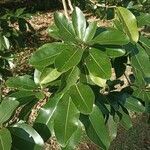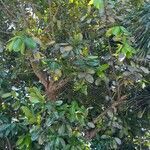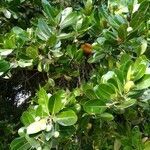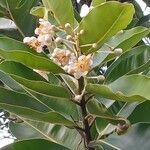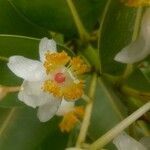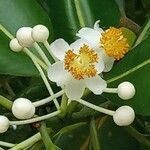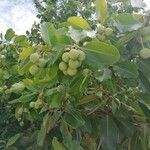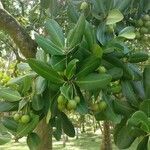Tree 4-10 m tall; trunk usually irregular; sap yellow. Leaves opposite, ellip-tical or obovate, 12-17 cm long, 6-9 cm wide, apically rounded or slightly retuse, basally rounded or obtuse, the costa prominent, stiff chartaceous, evanescent near the apex, subplane above, sharply elevated beneath, the lateral venation evident, ribs (veins and ducts) 18-20 per cm, the ducts not evident on the surface, the margins sometimes drying minutely revolute; petioles 1.5-2 cm long, drying dark brown, rounded concave above. Inflorescences axillary, racemes to ca. 13 cm long, flowers 1-4 at a node; the rachis minutely puberulent near the base; otherwise glabrous; pedicels 2-4 cm long, 1-4 at a node; bracts wanting; brac-teoles minute. Flowers showy, white, ca. 2 cm across, fragrant, perfect; sepals ca. 4, the outer pair coriaceous, rotund, the interior pair petaloid; petals 3-6, obovate, stamens numerous (200-350), the filaments basally connate, the anthers oblong linear, 1-2 mm long; ovary glabrous, the style 6-8 mm long, much ex-ceeding the ovary, the stigma peltate. Fruit subglobose, ca. 2.5 cm across, often apiculate, drying wrinkled and often glaucous brown, the locule occupying half the interior or less, the remainder packed with corky endocarp; seed ellipsoidal, ca. 2 cm long.
Tree to 25 (–35) m high; bark exudate clear golden yellow, sticky. Terminal bud plump, 4–9 mm long; uppermost axillary bud s to 1.2 mm long. Twigs farinose, puberulous or glabrous. Leaves: petiole 3–4 mm wide, glabrous to farinose; lamina elliptic, oblong, ovate or obovate, (5.5–) 8–20 (–23) cm long, (3.4–) 4–11.5 cm wide, base cuneate or rounded, apex rounded to retuse, acute or obtuse, midvein from above lamina base to midpoint depressed with or without raised margins, midvein above glabrous. Inflorescence axes glabrous or strigulose, usually unbranched, sometimes with 3 flowered branches. Pedicel (10–) 15–45 (–63) mm long, glabrous or strigulose. Flowers (13–) 20–24 mm diam.; tepals 8 rarely to 13; outer tepal s ovate to suborbicular; stamens ( 175–) 210–360 (–440), (3–) 5.7–9 mm long, anther oblong, 0.7–2 mm long; style (2.5–) 4.5–9 mm long; stigma peltate. Fruit globose, subglobose to obovoid, apex acuminate or apiculate to rounded, 25–50 mm long, 20–40 mm wide.
Trees 5-12 m tall. Bark gray brown or dark brown, thick, with longitudinal fissures, always exuding pellucid resins when wounded. Young shoots striate. Petiole robust, 1-2.5 cm; leaf blade shiny on both surfaces, broadly elliptic or obovate-elliptic, rarely oblong, 8-15 × 4-8 cm, thickly leathery, midvein raised abaxially, impressed adaxially, base rounded or broadly cuneate, apex rounded or emarginate. Thyrses in upper axils, 7-11-flowered, rarely shorter than 10 cm. Pedicel 1.5-4 cm. Flowers scented, white, 2-2.5 cm in diam. Sepals 4; outer 2: suborbicular, ca. 8 mm; inner 2: obovate, petaloid. Petals 4, oblanceolate to obovate, ca. 1.1 cm, concave, apex subtruncate or rounded. Ovary subglobose; stigma peltate. Mature fruit yellow, globose, ca. 2.5 cm in diam. Fl. Mar-Jun, fr. Sep-Nov. 2n = 32.
Trees usually with relatively short trunks and spreading branches, 7–25(–35) m. Leaves: petiole broadened and flattened toward blade, 10–25 mm; blade bright green, elliptic-oblong to obovate, 8–20 × 4.5–12 cm, base cuneate to rounded, finally decurrent, margins ± undulate, apex rounded to retuse, lateral veins prominent on both surfaces. Inflorescences in distal axils, 3–12-flowered. Flowers 2 cm diam.; sepals reflexed, outer pair orbiculate, 7–8 mm, inner pair obovate, ± petaloid, 10 mm; petals 4, white, obovate, 9–12 mm; ovary globose. Drupes green, globose to obovoid, 2.5–5 × 2–4 cm; stone subspheric, smooth. 2n = 32.
A medium sized tree. It grows up to 20 m tall. The branches spread out. The bark is light yellow-grey and smooth. The leaves are opposite and leathery. They are glossy green. The leaves are oval and 10-15 cm long by 4-6 cm wide. They have many fine side veins which come out at right angles to the midrib. The flowering structure is unbranched and they are in the axils of leaves. The flowers are white and have both sexes. They are 2-2.5 cm across. The fruit is round, ending in a point. It is 2.5 cm across and yellowish. It has a woody layer around the seed.
Leaves petiolate; lamina (8) 10 × (4–5) 5–10 cm., coriaceous, concolorous, broadly elliptic-oblong to obovate, rounded or shallowly emarginate at the apex, often with undulate margin, broadly cuneate at the base, with lateral nerves prominent on both surfaces; petiole 10–15 mm. long, broadened and flattened towards the apex.
Tree 15–30 m. high, usually with a short trunk and long branches; bark pale grey and fawn with shallow elliptic longitudinal fissures; branches smooth, tetragonal when young, eventually cylindric.
Sepals 4, reflexed, deciduous, outer ones c. 7–8 mm. long, orbicular, inner ones c. 10 mm. long, obovate, ± petaloid, rounded at the apex.
Stamens in 4 fascicles, ?, orange, equal to or rather shorter than the petals; anthers c. 1·5 mm. long, narrowly oblong.
Ovary deep pink, globose; style c. 4 times as long as the ovary, scarcely exceeding the stamens, flexuous.
Inflorescences 7–8 cm. long, racemose, lax, 3–12-flowered, in the axils of the upper leaves.
Petals 4, 9–12 mm. long, obovoid, narrower than the inner sepals, reflexed, deciduous.
Drupe c. 2·5–4 cm. in diam. when ripe, green, globose, smooth, with thick pericarp.
Flowers pedicellate; pedicels 1·5–4 cm. long, spreading to ascending.
Flower-buds 7–9 mm. in diam., globose.
